Gigabyte

Gigabyte has a lot of experience in the silent graphics market, and we have several ATI and NVIDIA cards from them for this review. An interesting statistic is that 90% of Gigabyte's shipped graphics solutions are silent, which makes a statement about the desirability of silent cards. Gigabyte is well represented in this review, having provided us with the highest number of solutions for testing. While their cards may not win any awards for good looks (the gold and turquoise coloring and unique heat sink designs aren't very easy on the eyes), they apparently handle silent operation very well, even at higher-than-stock clock speeds.
On the NVIDIA side, we have the Gigabyte 7600 GT, 7600 GS, 7300 GT, and 7300 GS. The Gigabyte 7600 GS comes shipped with its core overclocked to 450MHz, slightly higher (by 50MHz) than the stock version of this card. The Gigabyte 7300 GT also has a factory overclock of 450MHz core clock as opposed to the standard 350MHz core clock and an 800MHz memory clock verses the standard 667MHz memory clock on the 7300 GT. On the ATI side, we have the Gigabyte X1600 XT, X1600 Pro, X1300 Pro and X1300. All other Gigabyte cards aside from the 7600 GS and 7300 GT are clocked at reference speeds.
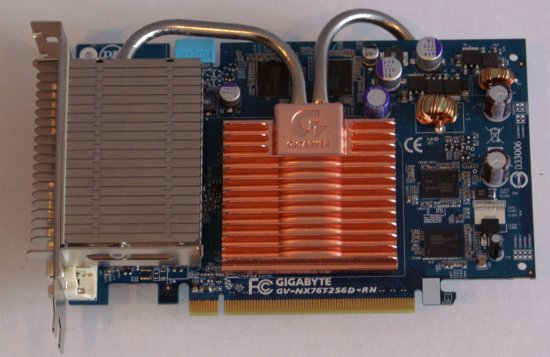
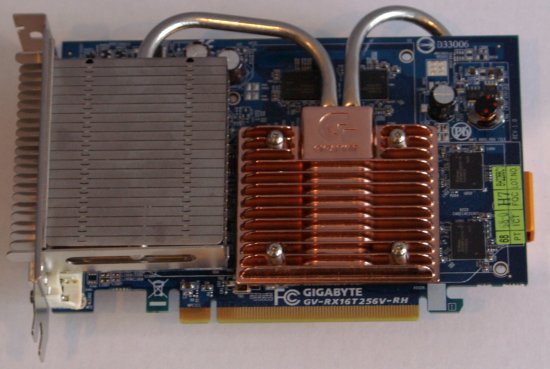
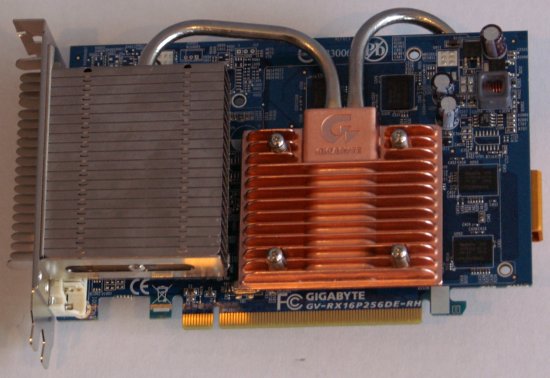
As we can see, the Gigabyte NVIDIA 7600 GT, ATI X1600 XT, and ATI X1600 Pro all have almost identical heat sink designs. The heat sinks are unique, with a bulky sink up front towards the DVI connections and heatpipes connecting to other heat sinks on the front and back of the card. The Gigabyte cards with this style heat sink are much more bulky than the other ones, and it's important to note that the silver heat sink uses up a second slot making these dual-slot solutions.

The Gigabyte X1300 Pro looks almost the same as the previous three Gigabyte cards; however, it is missing the extra heat sink on the back and the second metal pipe that would extend to it. The silver heat sink on the front still takes up an extra slot however, which is a point against this and the other three cards.
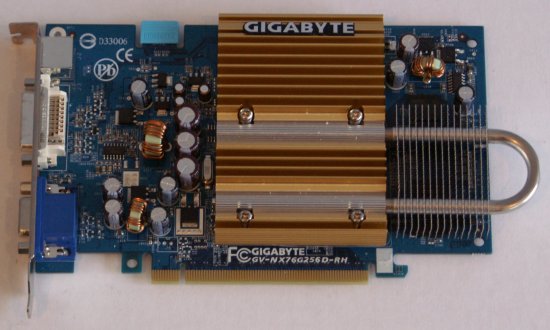
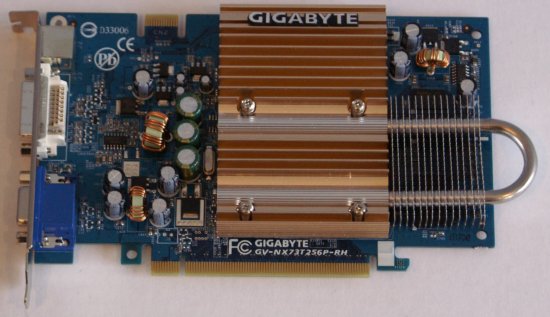
The Gigabyte 7600 GS and 7300 GT are very similar in appearance. The heat sinks on these cards are much more compact than those on the first four cards we mentioned. These cards don't take up an extra slot and only have a gold heat sink on the front, with a strange looking heatpipe running out and back in a "U" shape from the main heat sink. The heatpipe is attached to thin metal sheets, all in the name of increasing surface area and removing heat from the hotter portions of the card. These thin metal sheets seem a little delicate and might bend if the card is mishandled, though a slightly bent heat sink fin isn't really a major problem.
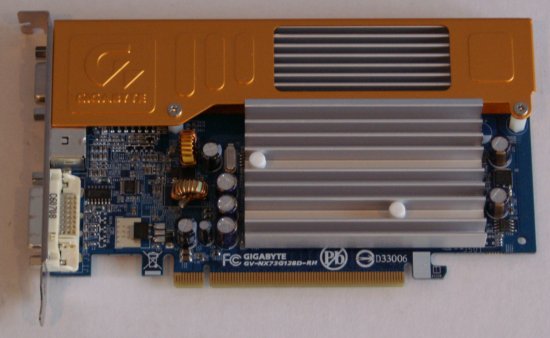
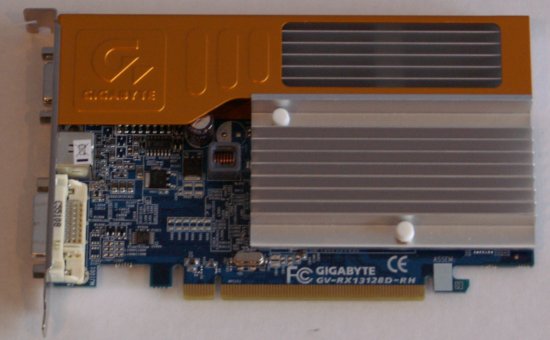
The Gigabyte 7300 GS and X1300 have heat sinks with a unique type of gold cover or hood running along the top part of the cards, over a silver heat sink on the cards' processor. The Gigabyte 7300 GS doesn't have a bridge connector on the top of the card for SLI operation, but it will still run in SLI (with a second card) without the bridge connection.
Gigabyte seems to have a definite plan about their custom heat sink designs, and after testing and overclocking these cards, there isn't much doubt that they perform well. They did, however, tend to get very hot to the touch after repeated testing, to the point where they became difficult to hold. We'll talk more about how well these cards overclocked in the "Overclocking" section.

Gigabyte has a lot of experience in the silent graphics market, and we have several ATI and NVIDIA cards from them for this review. An interesting statistic is that 90% of Gigabyte's shipped graphics solutions are silent, which makes a statement about the desirability of silent cards. Gigabyte is well represented in this review, having provided us with the highest number of solutions for testing. While their cards may not win any awards for good looks (the gold and turquoise coloring and unique heat sink designs aren't very easy on the eyes), they apparently handle silent operation very well, even at higher-than-stock clock speeds.
On the NVIDIA side, we have the Gigabyte 7600 GT, 7600 GS, 7300 GT, and 7300 GS. The Gigabyte 7600 GS comes shipped with its core overclocked to 450MHz, slightly higher (by 50MHz) than the stock version of this card. The Gigabyte 7300 GT also has a factory overclock of 450MHz core clock as opposed to the standard 350MHz core clock and an 800MHz memory clock verses the standard 667MHz memory clock on the 7300 GT. On the ATI side, we have the Gigabyte X1600 XT, X1600 Pro, X1300 Pro and X1300. All other Gigabyte cards aside from the 7600 GS and 7300 GT are clocked at reference speeds.



As we can see, the Gigabyte NVIDIA 7600 GT, ATI X1600 XT, and ATI X1600 Pro all have almost identical heat sink designs. The heat sinks are unique, with a bulky sink up front towards the DVI connections and heatpipes connecting to other heat sinks on the front and back of the card. The Gigabyte cards with this style heat sink are much more bulky than the other ones, and it's important to note that the silver heat sink uses up a second slot making these dual-slot solutions.

The Gigabyte X1300 Pro looks almost the same as the previous three Gigabyte cards; however, it is missing the extra heat sink on the back and the second metal pipe that would extend to it. The silver heat sink on the front still takes up an extra slot however, which is a point against this and the other three cards.


The Gigabyte 7600 GS and 7300 GT are very similar in appearance. The heat sinks on these cards are much more compact than those on the first four cards we mentioned. These cards don't take up an extra slot and only have a gold heat sink on the front, with a strange looking heatpipe running out and back in a "U" shape from the main heat sink. The heatpipe is attached to thin metal sheets, all in the name of increasing surface area and removing heat from the hotter portions of the card. These thin metal sheets seem a little delicate and might bend if the card is mishandled, though a slightly bent heat sink fin isn't really a major problem.


The Gigabyte 7300 GS and X1300 have heat sinks with a unique type of gold cover or hood running along the top part of the cards, over a silver heat sink on the cards' processor. The Gigabyte 7300 GS doesn't have a bridge connector on the top of the card for SLI operation, but it will still run in SLI (with a second card) without the bridge connection.
Gigabyte seems to have a definite plan about their custom heat sink designs, and after testing and overclocking these cards, there isn't much doubt that they perform well. They did, however, tend to get very hot to the touch after repeated testing, to the point where they became difficult to hold. We'll talk more about how well these cards overclocked in the "Overclocking" section.










49 Comments
View All Comments
imaheadcase - Thursday, August 31, 2006 - link
I guess to each his own, i play bf2 on a 19inch CRT monitor at 1024x768. But even if i had a better card i would still prefer lower rez.DerekWilson - Thursday, August 31, 2006 - link
it's an issue of how games work on the inside ...all the objects, shapes, characters, and landscapes are there no matter how you see them. everything is mathematically represented in the software. rendered onto your display is a viewport into the world. this viewport only allows you to see a fixed grid of colors. the color of each pixel is determined by a bunch of factors, but the largest contribution is made by the object that projects onto a particular pixel.
... on second thought, this is too hard for me to explain with out a lot of math. lets look at it another way.
when there's a naked person on tv, they decrease the resolution of the area over the persons naughty bits. this makes it harder to see what's really there because there is a smaller number of large pixels that can only represent one color each. it follows, then, that it would also be harder to shoot the person acurately in said bits.
I think your preference may be based on your experience with performance at higher resolutions. Responsiveness is necessary for a quality experience in games like bf2. If you get a faster card, I would encourage you to at least try a higher resolution.
blckgrffn - Thursday, August 31, 2006 - link
When it is in stock at newegg, its ~$90, not nearly $140.Nat
mostlyprudent - Thursday, August 31, 2006 - link
I would be interested to know how much noise (quantitatively) an actively cooled 7600GS or 7600GT contributes to a system built in a relatively quiet case like an Antec P150. I am familiar with some of the leaf blowers attached to the higher end cards, but wonder how much overall system noise savings you'ld get in the mid-range cards.wilburpan - Thursday, August 31, 2006 - link
One obvious use for silent video cards would be in an HTPC system, where quiet performance would be a priority. Can't have those noisy computer fans intrude on watching Snakes on a Plane, you know. :@) Anyway, it would have been nice to include some video playback benchmarks to see how these cards can handle playing back a 1080p HDTV signal, or similiar tests.ViRGE - Thursday, August 31, 2006 - link
Since HDTV is MPEG2, any modern video card should be able to handle a 1080P signal(since this is an either/or case, it either can or can't). The limitations come in to H.264, where the video decode engine may not be clocked high enough to do higher resolution decoding. Unfortunately, I'm not sure there's any 1080 commerical/usable content that would work with Cyberlink/Intervideo's H.264 decoders(the only ones with GPU acceleration), since Quicktime content doesn't work in those.DerekWilson - Thursday, August 31, 2006 - link
with nvidia, the video decode engine is clocked off the core -- it actually will run better on a card with fewer pipelines and a higher core speed ... iow, the 7600gt is a better video decode graphics card than a 7900gt at default clock speeds.a little counter intuitive, but there it is.
nvidia 7 series parts with a core clock of >450 MHz should have no problem accelerating 1080p decode on players that support purevideo.
MontagGG - Thursday, August 31, 2006 - link
Which of these have HDCP?DerekWilson - Thursday, August 31, 2006 - link
to my knowledge, none of the cards tested here support hdcp. but I will certainly try to confirm this ...